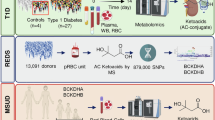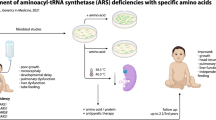Abstract
ABSTRACT.: We measured the biochemical response for four patients with maple syrup disease to pharmacologic doses of thiamine, and correlated their response to their branched chain a-ketoacid dehydrogenase activity. We observed a linear correlation between the concentrations of each plasma branched-chain amino acid and its corresponding ketoacid analogue. In addition, the renal tubular reabsorption of branched-chain amino and ketoacids was nearly complete within these physiologic concentrations. Three children responded to thiamine therapy with a reduction in concentration of plasma and urinary branched-chain amino and ketoacids. Each responder had at least 5% activity for branched chain a-ketoacid dehydrogenase in their mononuclear blood cells and in whole cell fibroblasts from cultured skin when compared to the activity in normal control cells. We propose that each child with maple syrup urine disease be assessed for their response to thiamine by quantifying the concentration of branched-chain amino acids in plasma before and after vitamin supplementation.
Similar content being viewed by others
Log in or create a free account to read this content
Gain free access to this article, as well as selected content from this journal and more on nature.com
or
Author information
Authors and Affiliations
Rights and permissions
About this article
Cite this article
Fernhoff, P., Lubitz, D., Danner, D. et al. Thiamine Response in Maple Syrup Urine Disease. Pediatr Res 19, 1011–1016 (1985). https://doi.org/10.1203/00006450-198510000-00012
Received:
Accepted:
Issue date:
DOI: https://doi.org/10.1203/00006450-198510000-00012
This article is cited by
-
Enhanced branched-chain amino acid metabolism improves age-related reproduction in C. elegans
Nature Metabolism (2024)
-
Maple syrup urine disease 1954 to 1993
Journal of Inherited Metabolic Disease (1994)
-
Orthomolecular therapy: Its history and applicability to psychiatric disorders
Child Psychiatry & Human Development (1988)



